1996 BUICK PARK AVENUE steering
[x] Cancel search: steeringPage 31 of 388
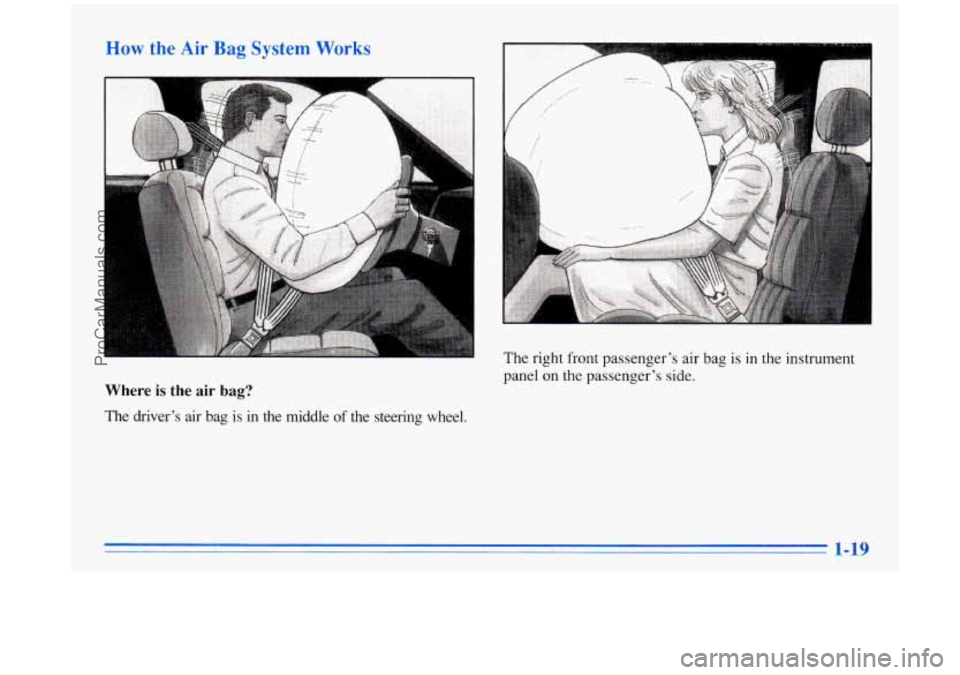
How the __ Bag System Works
Where is the air bag?
The driver's air bag is in the middle of the steering wheel. The
right front passenger's air bag
is in the instrument
panel on the passenger's side.
1-19
.-
ProCarManuals.com
Page 32 of 388
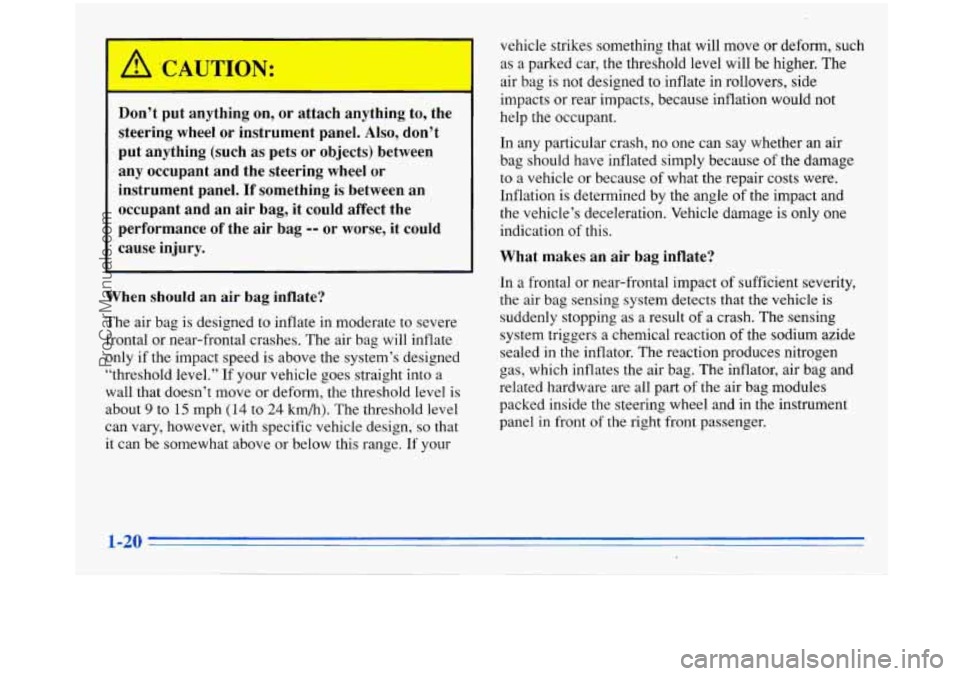
Don’t put anything on, or attach anything to, the
steering wheel or instrument panel. Also, don’t put anything (such
as pets or objects) between
any occupant and the steering wheel or
instrument panel. If something is between an
occupant and an air bag,
it could affect the
performance
of the air bag -- or worse, it could
cause injury.
When should an
air bag inflate?
The air bag is designed to inflate in moderate to severe
frontal or near-frontal crashes. The air bag will inflate
only if the impact speed
is above the system’s designed
“threshold level.” If your vehicle goes straight into a
wall that doesn’t move or deform, the threshold level is
about
9 to 15 mph (14 to 24 km/h). The threshold level
can vary, however, with specific vehicle design,
so that
it can be somewhat above or below this range. If your vehicle strikes something that will move
or deform, such
as a parked car, the threshold level will be higher. The
air bag is not designed to inflate
in rollovers, side
impacts or rear impacts, because inflation would not
help the occupant.
In any particular crash, no one can say whether an air
bag should have inflated simply because
of the damage
to a vehicle or because of what the repair costs were.
Inflation is determined
by the angle of the impact and
the vehicle’s deceleration. Vehicle damage is only one
indication of this.
What makes an air bag inflate?
In a frontal or near-frontal impact of sufficient severity,
the air bag sensing system detects that the vehicle is
suddenly stopping as a result of a crash. The sensing
system triggers a chemical reaction
of the sodium azide
sealed in the inflator. The reaction produces nitrogen
gas, which inflates the air bag, The inflator, air bag
and
related hardware are all part of the air bag modules
packed inside the steering wheel and in the instrument
panel
in front of the right front passenger.
ProCarManuals.com
Page 33 of 388
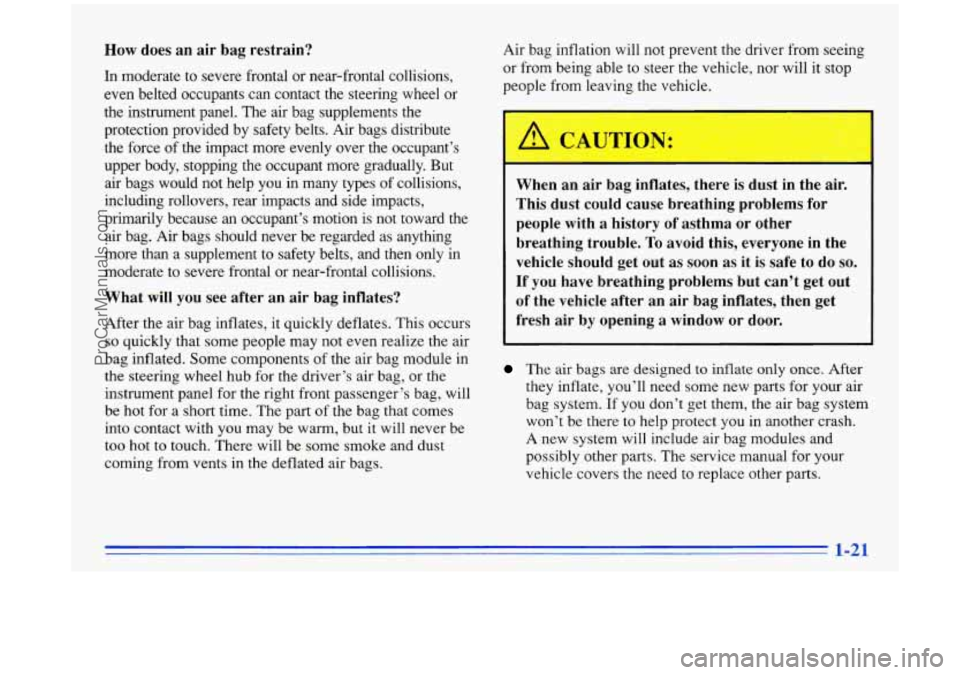
How does an air bag restrain?
In moderate to severe frontal or near-frontal collisions,
even belted occupants can contact the steering wheel or
the instrument panel.
The air bag supplements the
protection provided by safety belts. Air bags distribute
the force
of the impact more evenly over the occupant’s
upper body, stopping the occupant more gradually. But
air bags would not help you in many types
of collisions,
including rollovers, rear impacts and side impacts,
primarily because an occupant’s motion is not toward the
air bag. Air bags should never be regarded as anything
more
than a supplement to safety belts, and then only in
moderate to severe frontal or near-frontal collisions.
What will you see after an air bag inflates?
After the air bag inflates, it quickly deflates, This occurs
so quickly that some people may not even realize the air
bag inflated. Some components of the air bag module in
the steering wheel hub for the driver’s air bag, or the
instrument panel for the right front passenger’s bag, will
be hot for a short time. The part
of the bag that comes
into contact with you may be warm, but it will never be
too hot to touch. There will be some smoke and dust
coming from vents in the deflated air bags. Air bag inflation will not prevent
the driver from seeing
or from being able to steer the vehicle, nor will it stop
people from leaving the vehicle.
When an air bag inflates, there is dust in the air.
This dust could cause breathing problems for
people with a history of asthma or other
breathing trouble.
To avoid this, everyone in the
vehicle should get out as
soon as it is safe to do so.
If you have breathing problems but can’t get out
of the vehicle after an air bag inflates, then get
fresh air by opening a window or door.
The air bags are designed to inflate only once. After
they inflate, you’ll need some new parts for your air
bag system.
If you don’t get them, the air bag system
won’t be there
to help protect you in another crash.
A new system will include air bag modules and
possibly other parts. The service manual for your
vehicle covers the need
to replace other parts.
ProCarManuals.com
Page 34 of 388
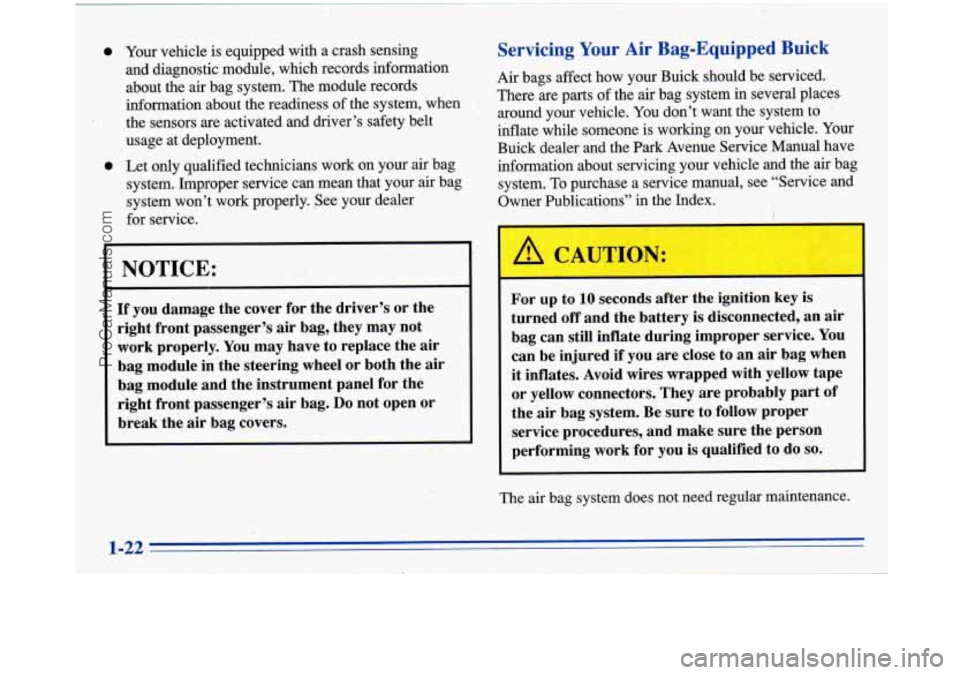
I‘ and diagnostic module, which records information
about the air bag system. The module records
information about the readiness
of the system, ‘when
the sensors are activated and driver’s safety belt
usage at deployment.
0 Let only qualified technicians work on your air bag
system. Improper service can mean that yoyr
air bag
syst,em won’t work properly. See your dealer
for service.
NOTICE:
If you damage the cover for the driver’s-or the
right front passenger’s
air bag, they may not
work properly.
You may have to replace the air
bag module in the steering wheel’or both the
air
bag module and the instrument panel for the right front passenger’s
air bag. Do not open or
break the
air bag covers.
Servicing Your Air Bag-Equipped Buick
Air bags affect how your Buick should be serviced.
There are parts
of the air bag system in several places
around your vehicle. You don’t want the system to
inflate while someone
is working on your vehicle. Your
Buick dealer and the Park Avenue Service Manual have
information about servicing your vehicle and the air bag
system.
To purchase a service manual, see “Service and
Owner Publications’’ in the Index.
For up to
10 seconds after the ignition key is
turned off and the battery is disconnected, an air
bag can still inflate during improper service. You
can be injured if you are close to an air bag when
it inflates. Avoid wires wrapped with ‘yellow tape
or yellow connectors. They are probably part of
the air bag system. Be sure to follow proper
service procedures, and make sure the person
performing work for you is qualified
to do so.
me air bag system does not need regular maintenance.
1-22
ProCarManuals.com
Page 69 of 388
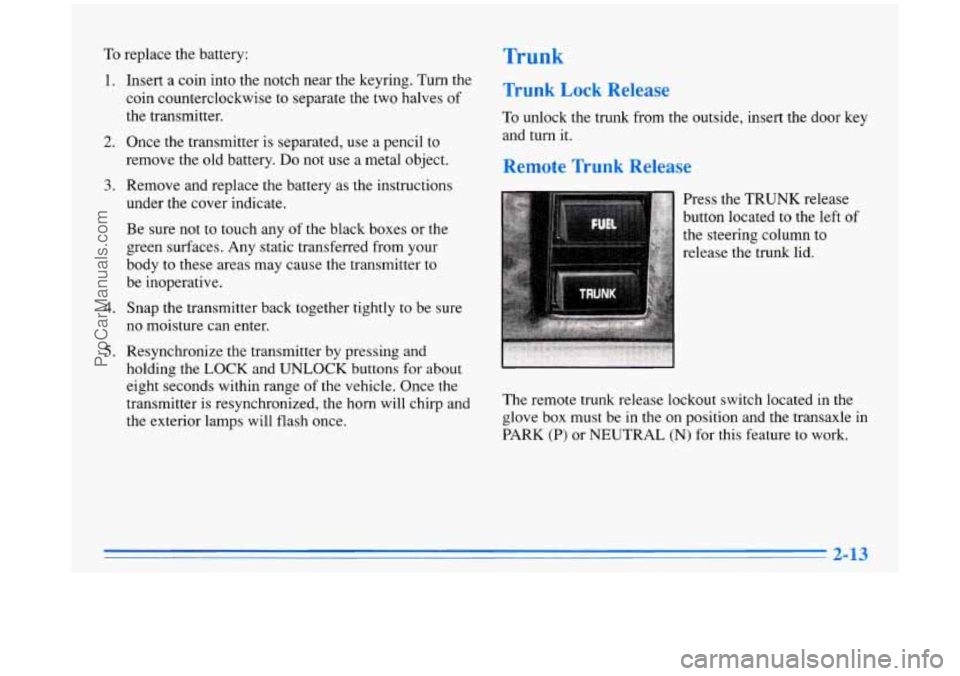
To replace the battery: Trunk
1.
2.
3.
4.
5.
Insert a coin into the notch near the keyring. Turn the
coin counterclockwise to separate the two halves
of
the transmitter.
Once the transmitter
is separated, use a pencil to
remove the old battery.
Do not use a metal object.
Remove and replace the battery as the instructions
under the cover indicate.
Be sure not to touch any
of the black boxes or the
green surfaces. Any static transferred from your
body to these areas may cause the transmitter to
be inoperative.
Snap the transmitter back together tightly to be sure
no moisture can enter.
Resynchronize the transmitter
by pressing and
holding
the LOCK and UNLOCK buttons for about
eight seconds within range of
the vehicle. Once the
transmitter is resynchronized, the horn will chirp and
the exterior lamps will flash once.
Trunk Lock Release
To unlock the trunk from the outside, insert the door key
and turn it.
Remote Trunk Release
Press the TRUNK release
button located
to the left of
the steering column to
release the trunk lid.
The remote trunk release lockout switch located in the
glove box must be in the on position and the transaxle in
PARK
(P) or NEUTRAL (N) for this feature to work.
ProCarManuals.com
Page 70 of 388
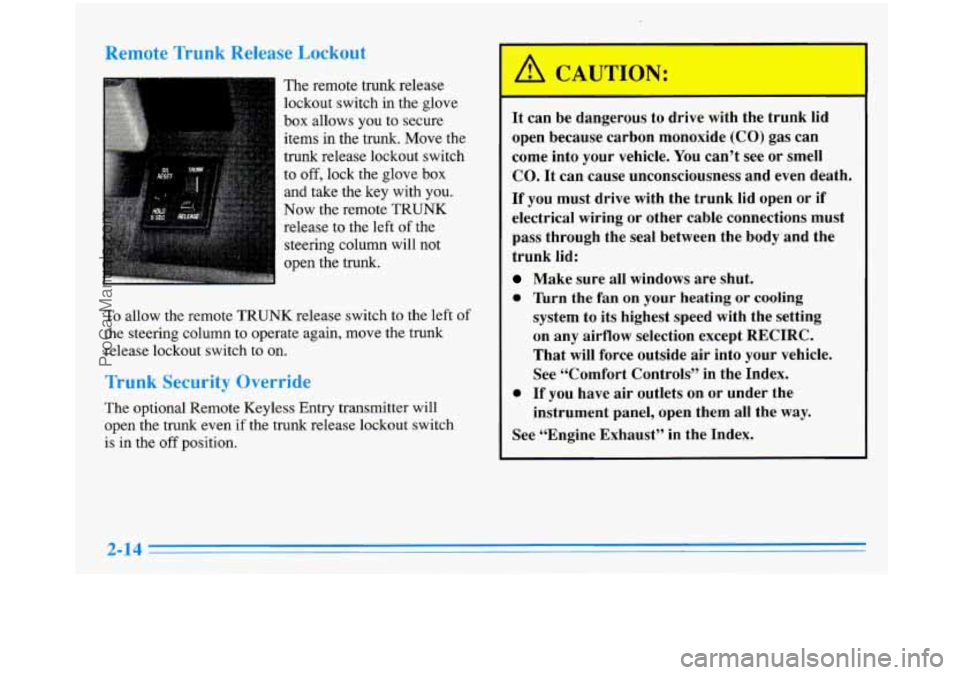
Remote Trunk Release Lockout
The remote trunk release
lockout switch in the glove
box allows you to secure
items
in the trunk. Move the
trunk release lockout switch
to off, lock the glove
box
and take the key with you.
Now the remote TRUNK
release to the left
of the
steering column will not
open the trunk.
To allow the remote TRUNK release switch to the left of
the steering column to operate again, move the trunk
release lockout switch
to on.
Trunk Security Override
The optional Remote Keyless Entry transmitter will
open the trunk even if the trunk release lockout switch
is in the off position. It can
be dangerous to drive with the trunk lid
open because carbon monoxide (CO) gas can
come into your vehicle. You can’t see
or smell
CO.
It can cause unconsciousness and even death.
If you must drive with the trunk lid open or if
electrical wiring or other cable connections must
pass through the seal between the body and the
trunk lid:
Make sure all windows are shut.
0 Wrn the fan on your heating or cooling
system to its highest speed with the setting
on any airflow selection except RECIRC.
That will force outside air into your vehicle.
See “Comfort Controls” in the Index.
0 If you have air outlets on or under the
instrument panel, open them all the way.
See “Engine Exhaust” in the Index.
ProCarManuals.com
Page 71 of 388
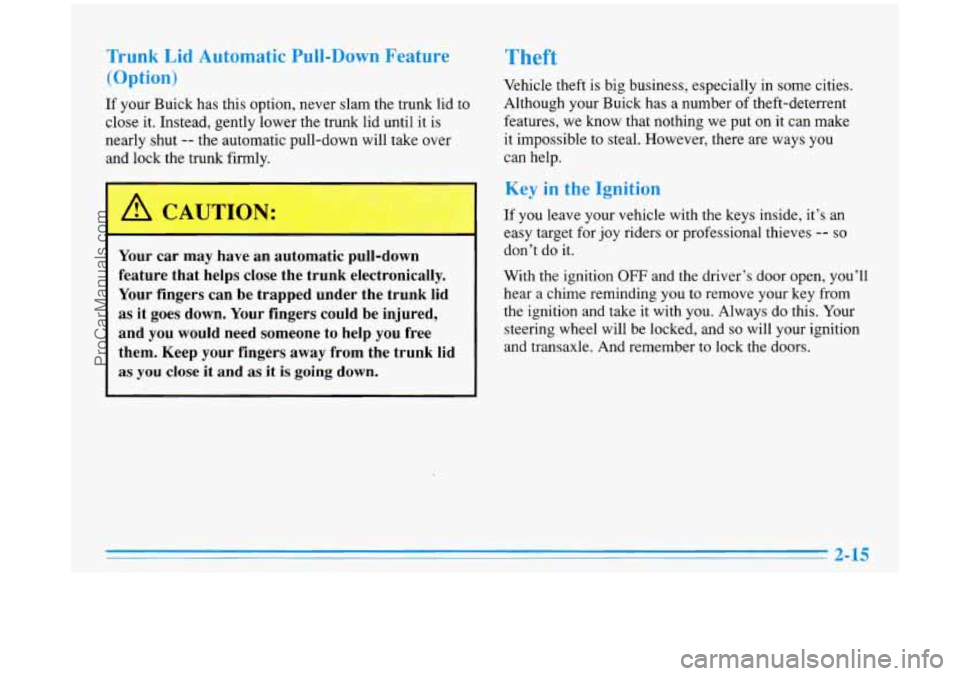
Trunk Lid Automatic Pull-Down Feature
(Option)
If your Buick has this option, never slam the trunk lid to
close it. Instead, gently lower the trunk lid until it is
nearly shut -- the automatic pull-down will take over
and lock the trunk firmly.
A CAUTION:
Your car may have an automatic pull-down
feature that helps close the trunk electronically.
Your fingers can be trapped under the trunk lid
as it goes down. Your fingers could be injured,
and
you would need someone to help you free
them. Keep your fingers away from the trunk lid
as you close it and as it is going down.
Theft
Vehicle theft is big business, especially in some cities.
Although your Buick has a number
of theft-deterrent
features, we know that nothing we put
on it can make
it impossible to steal. However, there are ways you
can help.
I Key in the Ignition
If you leave your vehicle with the keys inside, it’s an
easy target for
joy riders or professional thieves -- so
don’t do it.
With the ignition
OFF and the driver’s door open, you’ll
hear
a chime reminding you to remove your key from
the ignition and take it with you. Always do this. Your
steering wheel will be locked, and
so will your ignition
and transaxle. And remember to lock the doors.
ProCarManuals.com
Page 76 of 388
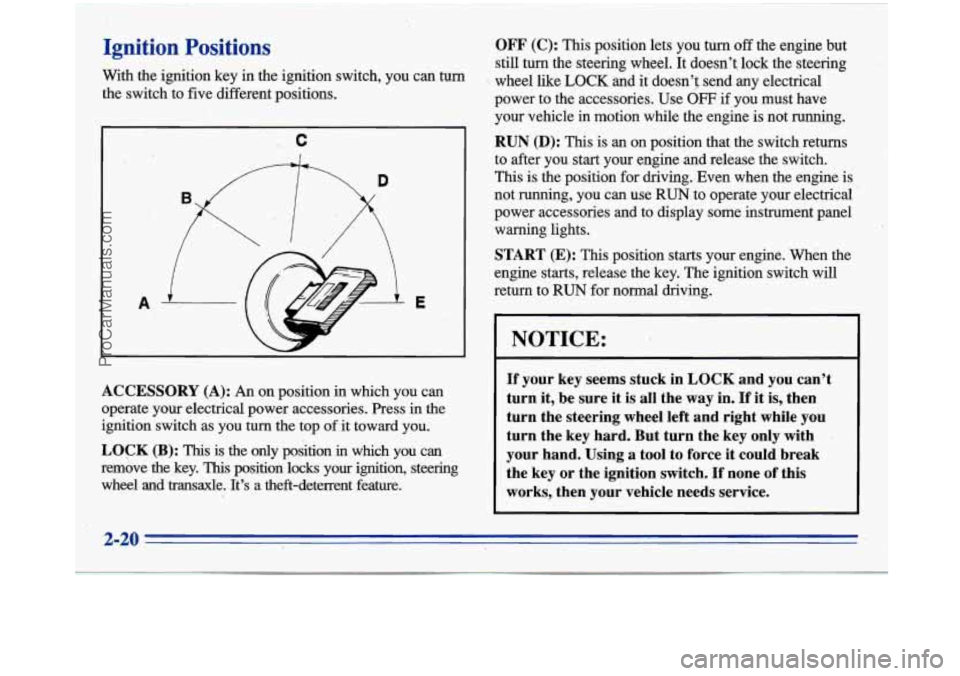
I.
I
Ignition Positions
With the ignition key in the ignition switch, you can turn
the switch to five different positions.
.. c
I
A E
ACCESSORY (A): An on position in which you can
operate your electrical power accessories. Press in the
ignition switch as you
hun the top of it toward you.
LOCK
(B): This is the only position in which yqu can
remove
the key. This position locks your ignition, steering
wheel and transaxle. It’s a theft-deterrent feature.
.. ,
OFF (C): This position lets you turn off the engine but
still turn the steering wheel. It doesn’t lock the steering
-.
wheel like LOCK and it doesn’f send any electrical
power to the accessories. Use
OFF if you must have
your vehicle
in motion while the engine is not running.
RUN (D): This is- an on position that the switch returns
to after you start your engine and release the switch.
This is the position for driving.-Even when the engine is
not running, you can use RUN to operate your electrical ’
power accessories and to display some instrument panel
warning lights.
START (E): This position starts your engine. When the
engine starts, release the key. The ignition switch
will
return to RUN for normal driving.
NOTICE:
If your key seems stuck in LOCK and you can’t
turn it, be sure it is all the
way in. If it is, then
turn the steering wheel left and right while you
turn the key hard. But turn the key only with
your hand. Using
a tool to force it could break
the key or the ignition switch.
If none of this
works, then your vehicle needs service.
ProCarManuals.com